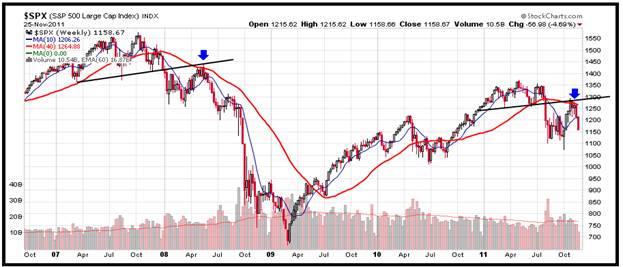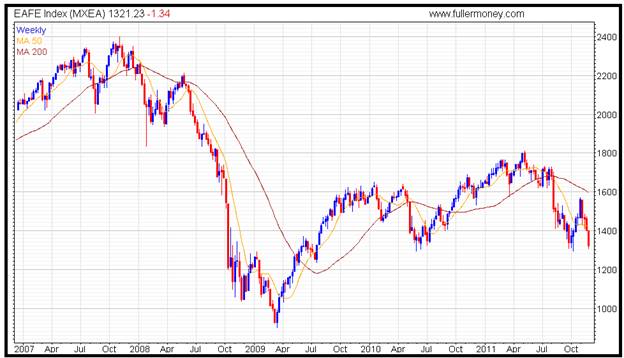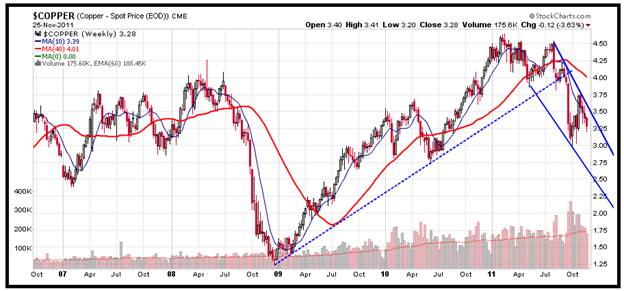Investors Should Prepare For A Chilly Winter
Stock-Markets / Financial Markets 2011 Dec 16, 2011 - 05:57 AM GMTBy: Puru_Saxena
 BIG PICTURE – The verdict is in and investors should prepare for a chilly winter.
BIG PICTURE – The verdict is in and investors should prepare for a chilly winter.
You will recall that in last month’s Money Matters, we explained that many key markets were at ‘make or break’ points. Since then, the market has spoken and it appears as though the ‘risk trade’ is in a primary downtrend. If our assessment is correct, investors who are ‘long’ risky assets will feel the cold breeze over the winter months.
Figure 1 shows the weekly chart of the S&P500 Index. Instead of looking at the Dow Jones Industrial Average, we prefer to review the S&P500 Index because this represents the largest 500 corporations in the world’s biggest economy. In our view, the direction of the S&P500 Index determines the fate of the vast majority of stock and commodity markets. Thus, the S&P500 Index is extremely important and for now, its weekly chart looks rather weak.
As you can see from Figure 1, the S&P500 Index topped out earlier this year and the recently concluded rally failed to climb above its overhead resistance. Furthermore, this rally failed around the 40 week (200 day) moving average and this is typical bear market action. More importantly, if you look at Figure 1 closely, you will observe a similar chart pattern in spring 2008. Back then, the market also rallied to its overhead resistance, however it failed to climb above the 40 day (200 day) moving average. During that cycle, what followed was an epic crash and over the next ten months, the S&P500 Index lost over 50% of its value! Turning to the present situation, we are not forecasting a similar outcome. However, in our eyes, the path of least resistance appears to be down. Should the S&P500 Index close below its October-low, a more serious decline will probably follow and cause financial pain to those who own stocks and other risky assets.
Figure 1: S&P500 Index

Source: www.stockcharts.com
It is interesting to observe that during this primary downtrend, major indices in the US have held up reasonably well. Whereas some of the high-flying stock markets in the developing world have already declined significantly, Wall Street is off by only 15% from its high recorded in spring 2011. Unfortunately, the stock markets of the developed nations within Europe, Austalasia and Far East have not performed well either and Figure 2 reveals that the MSCI EAFE Index has already declined by approximately 26% from its spring 2011 peak. Furthermore, the MSCI EAFE Index is currently trading around a key support level and a close below 1,290 will open up the possibility of a waterfall decline. Last but not least, the MSCI EAFE is currently trading below the 50-day moving average, which in turn is below the 200-day moving average; and this set up is typically seen during a bear market. Thus, the stock markets of the developed world are in a primary downtrend and this scenario calls for additional price declines.
Figure 2: MSCI EAFE Index

Source: www.fullermoney.com
Once again, we want to reaffirm that we are not predicting a nasty market crash; but merely highlighting the possibility of further weakness.
After a decade’s experience in the investment management business, we have come to the conclusion that the future is unknowable and the market can do absolutely anything. Thus, rather than predict, we now focus on managing risk and profiting from the ongoing trends.
At present, all the stock markets we monitor (except the Philippines Composite Index) are in a primary downtrend, and as long as this is the case, we will remain committed to our ‘short’ exposure and continue to hold onto a significant amount of US Dollar cash. Unfortunately, we do not know when this primary downtrend in ‘risk’ will end but when it does, we will cover our ‘short’ positions and re-position the portfolios for the next uptrend.
Given the wild swings in the financial markets and the increasing public-sector intervention, we are of the view that going forwards, a simple trend following approach will deliver much better returns than a prediction-based ‘buy and hope’ strategy.
Although we do not possess any fortune-telling skills, we do have the ability to dispassionately observe the present. In this regard, it is worth noting that the world’s fever chart (US Dollar Index) is rising and this is bad news for the ‘risk’ trade. Figure 3 shows that after briefly testing its 40 week (200 day) moving average, the US Dollar Index has rallied sharply. In our view, a clean break above the 80 level will usher in the next phase of the contraction and trigger another downleg in ‘risky’ assets.
Figure 3: World’s temperature is rising!

Source: www.stockcharts.com
Unlike us, if you are optimistic about the ‘risk’ trade and are tempted to ‘buy-the-dip’, you may want to note that various credit spreads are blowing out, 3-month LIBOR is rising, Credit Default Swaps on major US banks are rocketing higher and European bond yields are surging. Moreover, European and American bank stocks are getting decimated and the rating agencies are planning to announce further downgrades.
Last but not least, the European debt crisis now seems to be spreading to the ‘core’ and the disaster-show at the recent German Bund auction is yet another sign that a serious funding crisis is brewing in the Old World.
Bearing in mind all these facts, we are of the view that the ongoing primary downtrend in risky assets has further to run. Obviously, this downtrend will be punctuated by sharp, counter-trend rallies but as long as prices remain below the 200-day moving average, selling pressure should continue to dominate.
Even though the vast majority of the world’s stock markets are in a primary downtrend, it is astonishing that Wall Street has not changed its optimistic tune! For example, Goldman Sachs is still calling for a strong Q4 2011 GDP print and other houses are also urging investors to ‘buy-the-dips’. In our view, these experts and their followers are ignoring the risks at their own peril.
After all, if the global economy was strengthening and manufacturing activity was healthy, why would the price of copper be in a firmly established downtrend? Figure 4 shows that after forming a double top around the US$4.5 per pound level, Dr. Copper started to weaken and it is currently in a downtrend. It is worth noting that the price of copper is trading below the 10 week (50 day) moving average, which in turn is below the 40 week (200 day) moving average. Once again, the most critical industrial commodity is in bear market mode and this cannot bode well for the global economy.
Figure 4: Dr. Copper – a falling knife?

Source: www.stockcharts.com
In summary, with key stock as well as commodity markets in primary downtrends, and with rising credit strains, we are not prepared to accept any ‘risk’ on the long side. Rather than catch falling knives, we are simply watching the show with ample ‘dry powder’, so that when the next uptrend emerges, we will be ready to seize the opportunity.
Thus, our Discretionary Premium Portfolio is currently ‘net short’ and we are maintaining our large US Dollar cash exposure. Finally, our Discretionary Fund Portfolio (where we are unable to establish ‘short’ positions) is out of every asset and we are seeking shelter in US Dollar cash.
Puru Saxena publishes Money Matters, a monthly economic report, which highlights extraordinary investment opportunities in all major markets. In addition to the monthly report, subscribers also receive “Weekly Updates” covering the recent market action. Money Matters is available by subscription from www.purusaxena.com.
Puru Saxena
Website – www.purusaxena.com
Puru Saxena is the founder of Puru Saxena Wealth Management, his Hong Kong based firm which manages investment portfolios for individuals and corporate clients. He is a highly showcased investment manager and a regular guest on CNN, BBC World, CNBC, Bloomberg, NDTV and various radio programs.
Copyright © 2005-2011 Puru Saxena Limited. All rights reserved.
© 2005-2022 http://www.MarketOracle.co.uk - The Market Oracle is a FREE Daily Financial Markets Analysis & Forecasting online publication.



